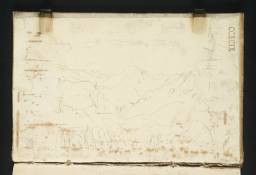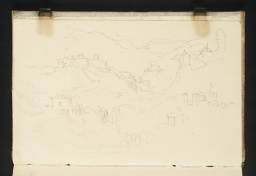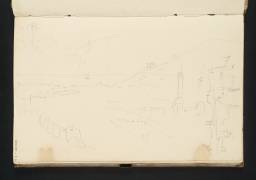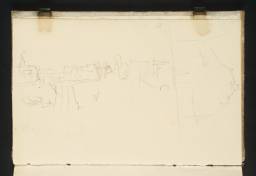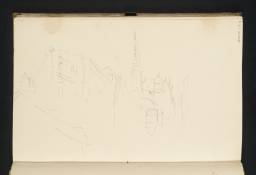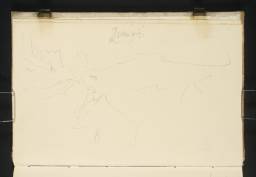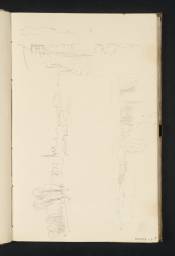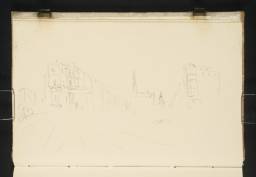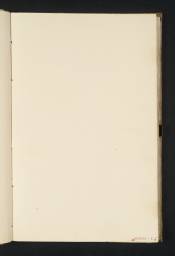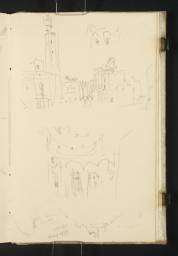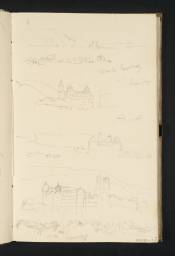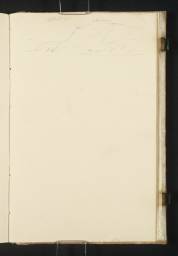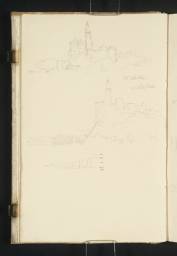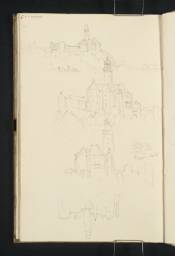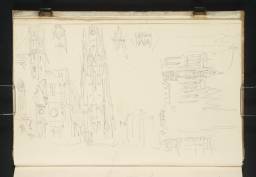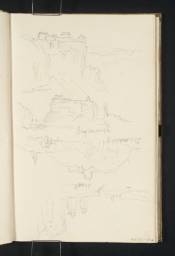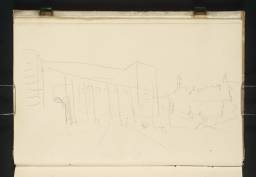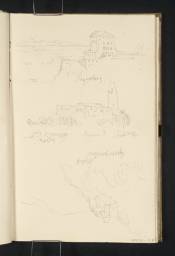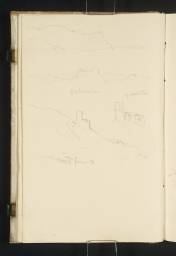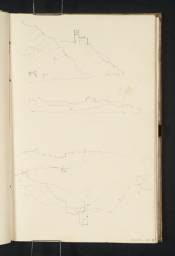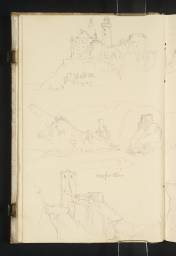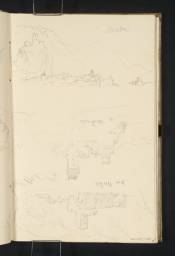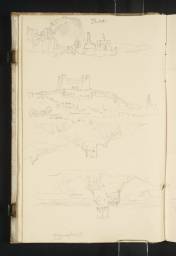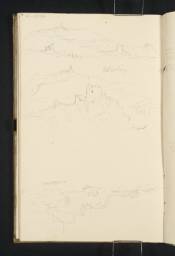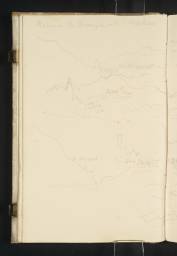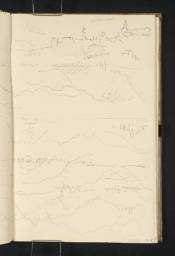Turner Bequest CCXCIX 1–67
Sketchbook bound in boards, covered in buff wove paper, with single blind-ruled lines at outer edges; three leather pencil loops
66 leaves and past-downs of cream wove paper, page size 173 x 123 mm
Unidentified Austrian maker; various leaves watermarked partially with ‘J. Wha’ or ‘J. Wh’ and correspondingly ‘tman’ or ‘atman’
Numbered 238 as part of the Turner Schedule in 1854 and endorsed by the Executors of the Turner Bequest on front cover (see main catalogue entry)
Blind-stamped with Turner Bequest monogram on front cover, towards top left
Inscribed in pencil ‘CCXCIX’ on front cover, top left
Stamped in black ‘CCXCIX’ on front cover, top right
66 leaves and past-downs of cream wove paper, page size 173 x 123 mm
Unidentified Austrian maker; various leaves watermarked partially with ‘J. Wha’ or ‘J. Wh’ and correspondingly ‘tman’ or ‘atman’
Numbered 238 as part of the Turner Schedule in 1854 and endorsed by the Executors of the Turner Bequest on front cover (see main catalogue entry)
Blind-stamped with Turner Bequest monogram on front cover, towards top left
Inscribed in pencil ‘CCXCIX’ on front cover, top left
Stamped in black ‘CCXCIX’ on front cover, top right
Accepted by the nation as part of the Turner Bequest 1856
Exhibition history
References
This sketchbook records a lengthy but relatively straightforward itinerary after Turner left Venice for the last time on Thursday 3 September 1840 (see the tour’s Introduction), sailing across the ‘spectacular gulf of Trieste’1 at the north end of the Adriatic to Trieste itself, passing by road north-eastwards through modern Slovenia to Graz in Austria, and onwards in that direction to Vienna. From the capital he travelled west by steamer2 up the River Danube by way of Linz, and on into Germany at Passau,3 where he took up the Venice; Passau to Würzburg sketchbook again (Tate; Turner Bequest CCCX), having likely used it for his last drawings of Venice.
The present book, only in use ‘for about a week’,4 is packed with sketches; its sometimes wayward topographical sequence, largely but far from consistently in reverse of the subsequent foliation,5 combined with Finberg’s not recognising the Trieste views in his initial 1909 Inventory checklist, led to a great deal of convoluted speculation as to its significance in relation to Turner’s later tours. It was only firmly established as belonging to 1840 by Cecilia Powell in 1995, as discussed below.
As with various other Continental sketchbooks, Finberg had initially dated it speculatively to about 1837–40,6 calling it ‘The Danube and Graz Sketch Book’.7 This was probably derived from John Ruskin’s laconic endorsement, quoted in full below, mentioning only the River ‘Danube’, and Turner’s written note of ‘Gratz’ (then the conventional English form) inside the front cover (D41222; see also folio 44 recto; D30084), although many of the Danube views are also labelled with fairly clear place names. The Turner scholar C.F. Bell annotated a copy of the Inventory: ‘A number of Trieste’ after Finberg’s ‘Danube and Graz’ title.8 Finberg transcribed and acknowledged Bell’s note in his own copy,9 adding ‘Linz to Vienna’ after ‘Danube’,10 but also positing ‘Vienna to Linz’.11 In 1930’s In Venice with Turner, he dated the book to 1835 as part of a long, speculative outward itinerary to Venice,12 only commenting in passing: ‘Contains sketches on the Danube between Vienna and Lintz. I am not sure that he went to Graz; the sketches on pp. 42 to 45 [D30080–D30086] seem to have been made from a distance.’13
In his 1971 discussion of Turner and Venice, Hardy George attempted to unravel the problem, with the help of other unpublished notes by Bell:
If Bell is correct in identifying sketches on pages 59–65 [D30113–D30125] ... as Trieste, and in dating the book 1840, some missing links in Turner’s return journey of that year might be furnished by associating the sketches in this book with the somewhat jumbled ones in the Coburg, Bamberg and Venice Sketch Book (cccx – which perhaps should be titled “Venice to Bamberg” [Tate; now firmly dated to 1840 as Venice; Passau to Würzburg]). Finberg tried to associate the Danube and Graz Sketch Book with the “1835” tour from Vienna, but did not quite know what to do with it. ... Bell associated the book with the 1840 tour, but thought that Turner came down from Vienna by way of Graz and Trieste (see Bell annotations in Finberg).’14
However, by 1984 George was linking this book to Turner’s 1833 tour to Venice, associating it with the Salzburg and Danube sketchbook of that year (Tate; Turner Bequest CCC), on account of corresponding views there along the Danube between Linz and Vienna, one of the few points were the itinerary coincided with 1840’s (albeit in opposite directions). He noted that the present book ‘includes sketches labelled “Shotwer”, which is perhaps Schottwien, between Vienna and Graz (southwest of Neustadt)’ on folio 41 recto (D30078), which he understandably found hard to reconcile with the already ‘round-about nature’ of the notional tour he proposed.15
Cecilia Powell eventually resolved these issues by showing how the route set out in this sketchbook slots logically and precisely into the wider scheme of Turner’s travels through Austria and Germany in 1840, and as a result the book has come to be known as ‘Trieste, Graz and Danube’.16 Its physical similarity to two other contemporary sketchbooks is another factor, as discussed in the technical notes below. Turner sketched so many places (particularly in quick succession up the Danube between Vienna and Passau), identifiable through his inscriptions or Powell’s research,17 that little remains but to list them with brief linking comments. For the convenience of cross-referencing, multiple drawings of the same subject are numbered in ranges as foliated and accessioned, albeit the general trend of the itinerary is from the ‘back’ of the book.
There are numerous views in and around Trieste (now in a narrow Italian coastal strip encompassed by Slovenia), with its lighthouse and the heights rising above the harbour to the Castello di San Giusto and adjacent cathedral, working in from the back (D30129; Turner Bequest CCXCIX 67) in a sequence beginning with the approach off the Adriatic coast from Venice; see under folio 57 recto (D30109). Powell has suggested that Turner took this short sea voyage as a change from an Alpine route ‘in order to enjoy what was for him a novel experience’, facilitated by modern steamer services.18
Turning inland between Trieste and Graz, Turner apparently followed the established ‘State Road’ route north-east through Austrian territories.19 Most of this leg was through what is now Slovenia, on the fringes of the Balkans at the northern end of the former Yugoslavia – the furthest the artist ever ventured into south-eastern Europe. The road passed through Sežana (Sessana or Sessina in the English guidebooks) and Planina (folios 49 verso and likely 50 recto; D30095–D30096, show the nearby Ravbar’s Tower), to Ljubljana (otherwise Laibach), where Turner had time for two drawings, thought until recently to show Graz (folios 47 verso, 48 verso; D30091; D30093). The route continued east through Vransco (Franzen) to Celje (Cilly) and Slovenska Bistrica (Windisch-Feistritz) to Maribor (Marburg); by now the road had turned north, soon entering Austria itself and arriving at last in Graz after a meandering journey of around 210 miles.20
There are numerous views of this ‘fine old town on the river Mur with Italianate buildings’, as Powell has described it, dominated by the ‘enormously impressive’ albeit somewhat dilapidated riverside Schlossberg;21 see under folio 41 verso (D30079). From Graz the established route to Vienna would have taken him north through Peggau to Bruck an der Mur, then north-east though Mürzzuschlag to Schottwien and on through Neuenkirchen to Wiener Neustadt. From there the route turned more northerly again, reaching Vienna after about 130 miles.22 The only clearly identified sketch on this part of the journey shows Schottwien (folio 41 recto; D30078), about half-way, though a castle in the vicinity may be depicted on D30079 in addition to the Graz view there.
There are only a handful of sketches at Vienna, where he arrived on 7 September and was duly recorded in the Wiener Zietung of three days later;23 see under folio 40 recto (D30076), under which the many views in and around the city in the 1833 Salzburg and Danube sketchbook (Tate; Turner Bequest CCCXI) are listed. He was staying at the Stadt Frankfurt, ‘a substantial hotel in Seilergasse, just off the Graben’, and ‘stepped outside and drew a few sketches of the Stefansdom including one from the Stock-im-Eisen Platz.’24
Turner seems to have spent more time there perusing local topographical views, as Powell has noted that fifteen of the drawings in this book (folios 10 recto, 11 recto, 12 verso–13 verso; D30020, D30022, D30025–D30027) are not from his direct observations, but rather thumbnail sketches from existing prints, mostly identified as by Jakob Alt (1789–1872), likely seen in the hotel.25 Most were lithographs from Adolf Kunike and Alt’s Donau-Ausichten vom Ursprunge bis zum Ausflusse in Meer (‘Danube views from its source to the sea’) a monthly subscription series of 264 prints issued in the city between 1819 and the mid 1820s.26 As noted in the individual entries, some of the subjects were further west or east than the stretch of the river he would subsequently travel.27
Setting off west up the Danube, the next leg of the tour took Turner some 200 miles west to Passau.28 As cross-referenced under the individual subjects, most of the places he drew here in passing were familiar from his 1833 tour, when he had sailed the other way between Linz and Vienna.29 Powell has observed that the views were ‘never as finely drawn as those in his earlier Salzburg and Danube book’, mainly owing to his now more rapid progress ‘by steamer, a regular service between Regensburg and the Black Sea having been established in 1837’.30 On the present trip he sketched the following sights, often from more than one angle:
the Leopoldsberg hill (see under folio 7; D30014); Klosterneuburg (folio 7 recto; D30014); Burg Kreuzenstein (see under folio 11 verso; D30023); Burg Greifenstein (see under folio 11 verso; D30023); ?Altenberg, Sankt Andrä-Wördern (folios 6 verso and 7 verso; D30013, D30015); Hollenburg (folio 14 recto; D30028); (Rossatz-)Arnsdorf, near Krems (see under folio 14 verso; D30029); the Sankt Michael church, near Weissenkirchen (see under folio 14 verso; D30029); Spitz (see under folio 15 recto; D30030); Melk Abbey (folio 25 verso; D30050); Säusenstein (see under folio 15 recto; D30030); Schloss Persenbeug (folios 55 verso–56 recto; D30107–D30108); Ybbs (folios 55 verso–56 recto; D30107–D30108); Freyenstein castle (see under folio 38 verso; D30073); Sarmingstein (folios 38 verso and 39 recto; D30073–D30074)
Around Freyenstein, he twice noted that it was Thursday morning (see folios 39 recto and verso; D30074–D30075), indicating 10 September, a week after leaving Venice, three days since reportedly being in Vienna and four before his presence in Regensburg was recorded31 upriver again from Passau. A concentrated burst of views along a short stretch followed, while the boat slowly negotiated hazardous rocks and associated currents between Sankt Nikola and Grein:32
Sankt Nikola (folio 38 recto; D30072); the Wirbel whirlpool and Burg Hausstein (folios 37 recto and verso; D30070–D30071); Burg Werfenstein, near Struden (see under folio 32 recto; D30060); the Strudel rapids and Schloss Wörth (see under folio 31 verso; D30059); Schloss Greinburg, at Grein (see under folio 15 verso; D30031)
Undated MS note by Bell (died 1966) in copy of Finberg 1909, Prints and Drawings Room, Tate Britain, II, p.967.
Undated MS note by Finberg (died 1939) in interleaved copy of Finberg 1909, Prints and Drawings Room, Tate Britain, II, opposite p.967.
Albeit listing the Trieste-Graz leg ‘in the briefest possible way’ for ‘reasons of space’, as noted ibid., p.240.
From there it was a straightforward run to Linz:
Schloss Wallsee (see under folio 8 verso; D30017); Enns (folio 24 verso; D30048); Mauthausen (folios 24 verso, 25 recto (D30048–D30049); Spielberg (or Spilberg) castle (see under folio 24 verso; D30048); Linz (folio 26 recto; D30051)
Now the scenery became new to Turner, as he continued by way of multiple viewpoints up and down ‘several spectacular bends’, showing the Danube as ‘wild and deserted as it was held in popular imagination, inhabited only by gaunt and distant ruins high on the horizon’, as Powell has described it,33 before reaching the Austrian customs station at Engelhartszell:
Schloss Ottensheim (see under folio 25 verso; D30050); Schloss Neuhaus (see under folio 23 verso; D30046); Aschach (folio 26 verso; D30052); Schlögen, Haichenbach (the Kerschbaumer Schlössl), Burg Marsbach and Wesenufer (see under folio 21 recto; D30041); Schloss Rannariedl (see under folio 20 verso; D30040); Engelszell Abbey (folio 20 verso; D30040); Engelhartszell (folio 20 recto; D30039)
Upstream, the Danube marks the boundary between Austria on the south bank, and Germany on the north:
Finally, Turner disembarked at the Bavarian city of Passau, its centre impressively situated on a peninsula at the confluence of the Inn with the Danube. Powell has described the ‘mood’ here as ‘entirely different. From the moment the city first comes into sight [see folio 18 recto; D33036], its spires and domes impossibly clustered on what seems to be an island site, dark woods and tortuous bends are quite forgotten.’34 The artist made numerous pencil and watercolour studies in the vicinity in this sketchbook and others (see under folio 31 recto; D30058). An airy contemporary watercolour of Passau, Germany, at the Confluence of the Rivers Inn and Danube (National Gallery of Ireland, Dublin),35 seen as if from high above a steamer in the foreground, perhaps recalls his arrival (see under D33036); it is the only tangible outcome of this part of the tour outside the holdings of the Bequest.
The customary Turner Bequest executors’ endorsement is written towards the top of the otherwise blank front cover, in ink ‘No 238. | Containing 65 Leaves Pencil | Sketches, most on both sides. | H.S. Trimmer | C. Turner’ and in pencil ‘C.L.E.’ and ‘JPK’. The signatories are Henry Scott Trimmer, Charles Turner, Charles Lock Eastlake and John Prescott Knight. Finberg recorded Ruskin’s note on a separate wrapper (since lost): ‘238. Danube. Some fine fortress outlines, but loose. May be shown as it is.’36
Technical notes
How to cite
Matthew Imms, ‘Trieste, Graz and Danube Sketchbook 1840’, sketchbook, September 2018, in David Blayney Brown (ed.), J.M.W. Turner: Sketchbooks, Drawings and Watercolours, Tate Research Publication, December 2019, https://www

